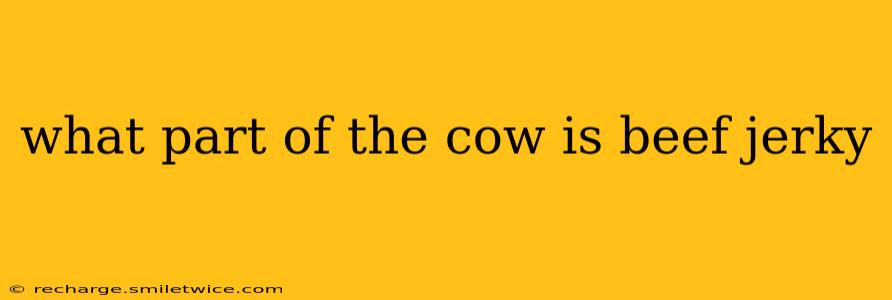What Part of the Cow is Beef Jerky?
Beef jerky, that chewy, savory snack, comes from a variety of cuts of beef. There isn't one single "part of the cow" designated solely for jerky production. The best cuts for jerky are those that are relatively lean and have a good amount of muscle fiber to retain texture and flavor during the drying process. This often leads to a blend of cuts being used by manufacturers.
Let's explore some common sources:
What cuts of beef are typically used for jerky?
Many different cuts can be utilized, depending on the manufacturer's preferences and the desired texture and flavor profile. However, some popular choices include:
-
Top Round: This cut is a lean muscle found in the hindquarters. Its leanness is ideal for jerky, preventing excessive fat rendering during the drying process. The resulting jerky is often quite firm and chewy.
-
Sirloin: Another lean cut from the hindquarters, sirloin provides a good balance of flavor and tenderness. Jerky made from sirloin tends to be less chewy than that made from top round.
-
Eye of Round: This cut, also from the hindquarters, is extremely lean, producing a very firm and chewy jerky.
-
Flank Steak: While generally known for its suitability for grilling, flank steak's tough muscle fibers also lend themselves well to jerky. The resulting jerky will be more flavorful, but also potentially tougher than other cuts.
-
Other Cuts: Many producers might use a combination of cuts or even less common cuts, depending on availability and pricing. The exact blend often isn't explicitly stated on packaging.
Is it made from just one muscle?
No, it's not usually made from just one specific muscle. Most commercially produced jerky utilizes a combination of cuts, often trimmings and less desirable parts of the animal that are still perfectly suitable for jerky production after being trimmed of excessive fat. This contributes to the overall cost-effectiveness of producing beef jerky.
Does the cut affect the taste and texture?
Absolutely! The cut significantly influences both the taste and texture. Leaner cuts like top round and eye of round generally yield a chewier, more firm jerky. Cuts with a bit more marbling (fat) will generally result in a tenderer, juicier (though potentially less shelf-stable) jerky. The flavor profile can also vary slightly depending on the cut, due to differences in muscle fiber and fat distribution.
Can I make jerky at home from any cut of beef?
While you can attempt to make jerky from various cuts at home, success will depend on the leanness and toughness of the chosen meat. Leaner cuts are easier to dehydrate properly and will result in a more enjoyable texture. Fattier cuts may render excessive fat during drying, leading to a less palatable outcome. Careful trimming of excess fat is essential regardless of the cut.
In conclusion, while several cuts are commonly used for beef jerky, there isn't a single definitive answer to "what part of the cow?" It often involves a blend of lean, muscular cuts, chosen for their ability to produce a flavorful and chewy final product. The specific cut or combination of cuts will affect the final texture and taste.
